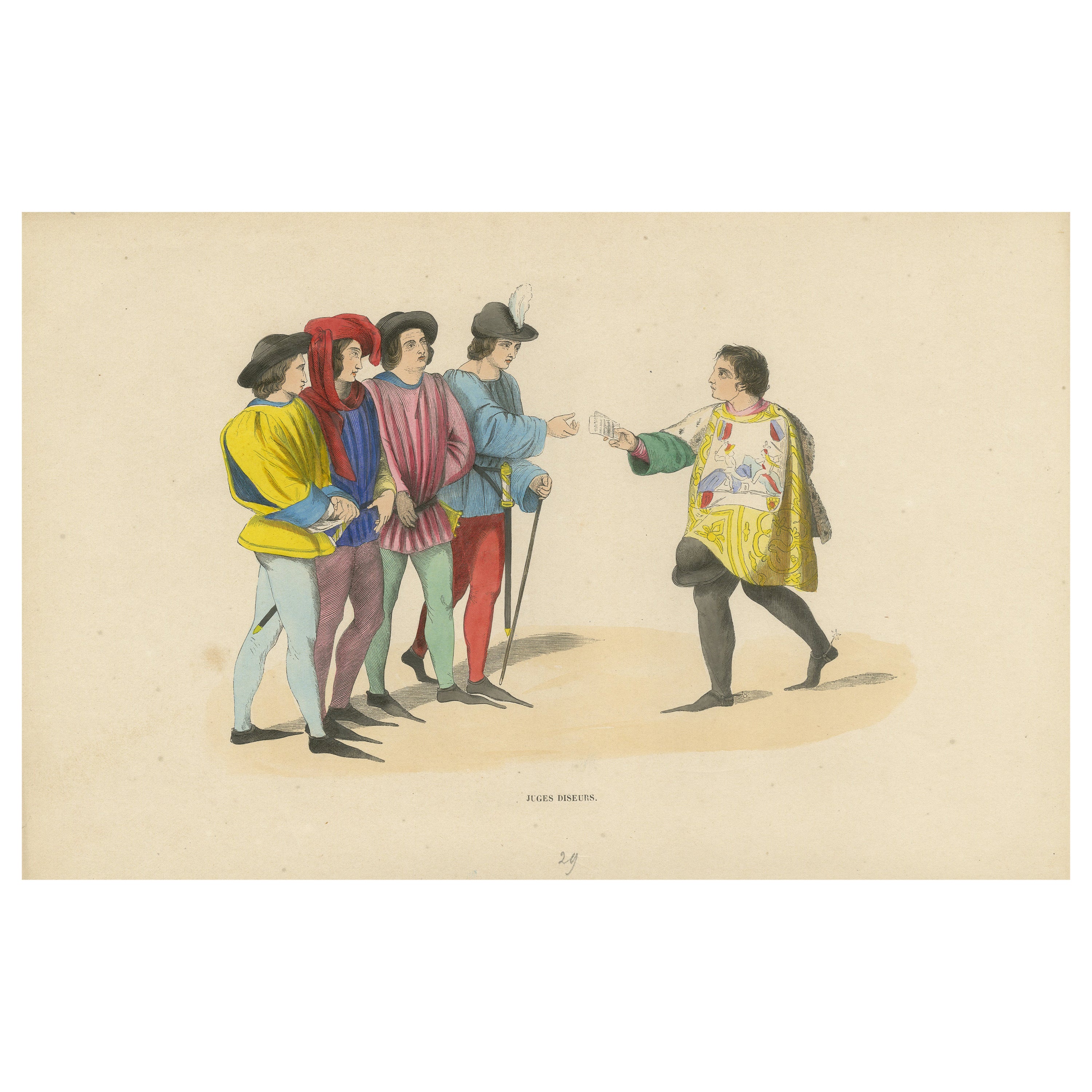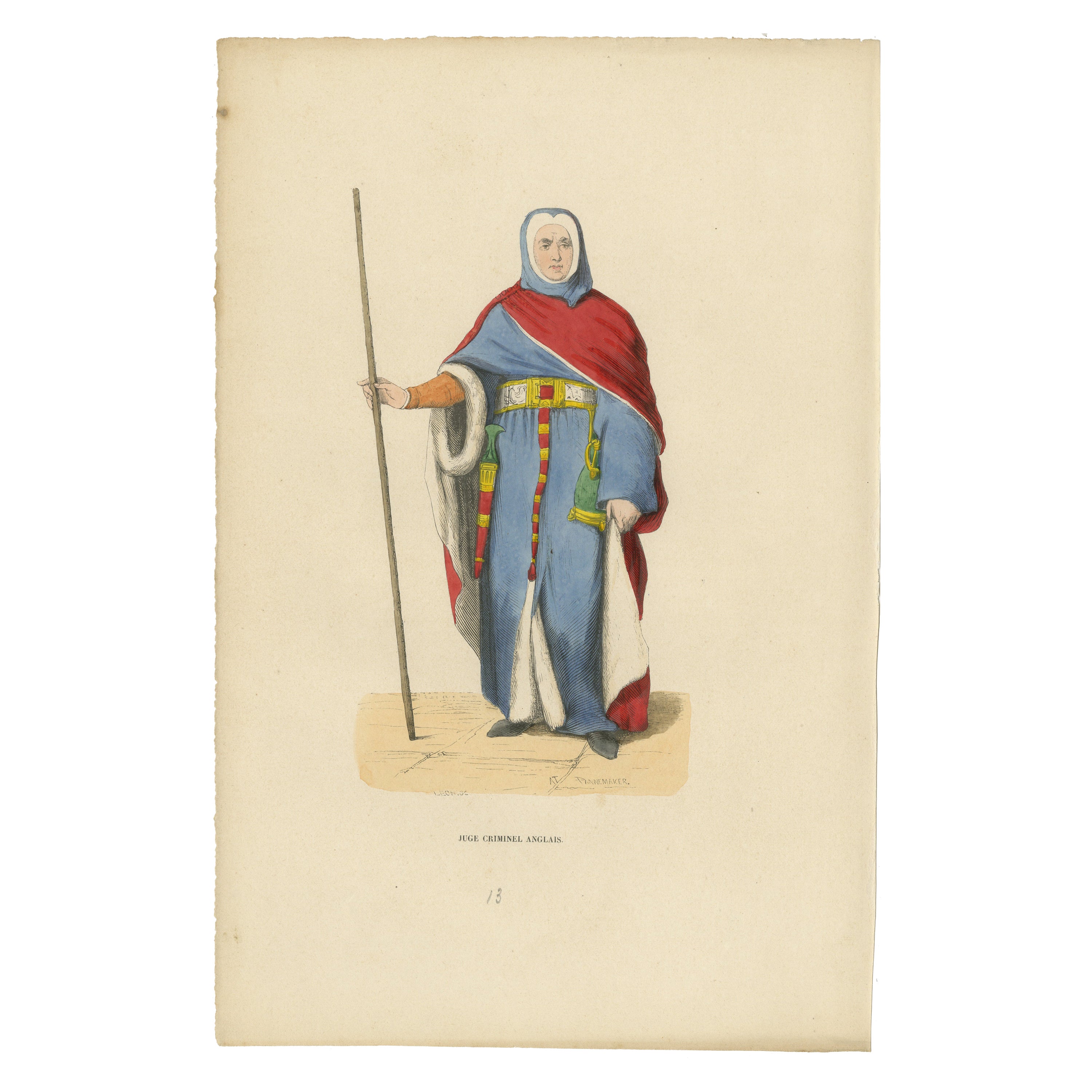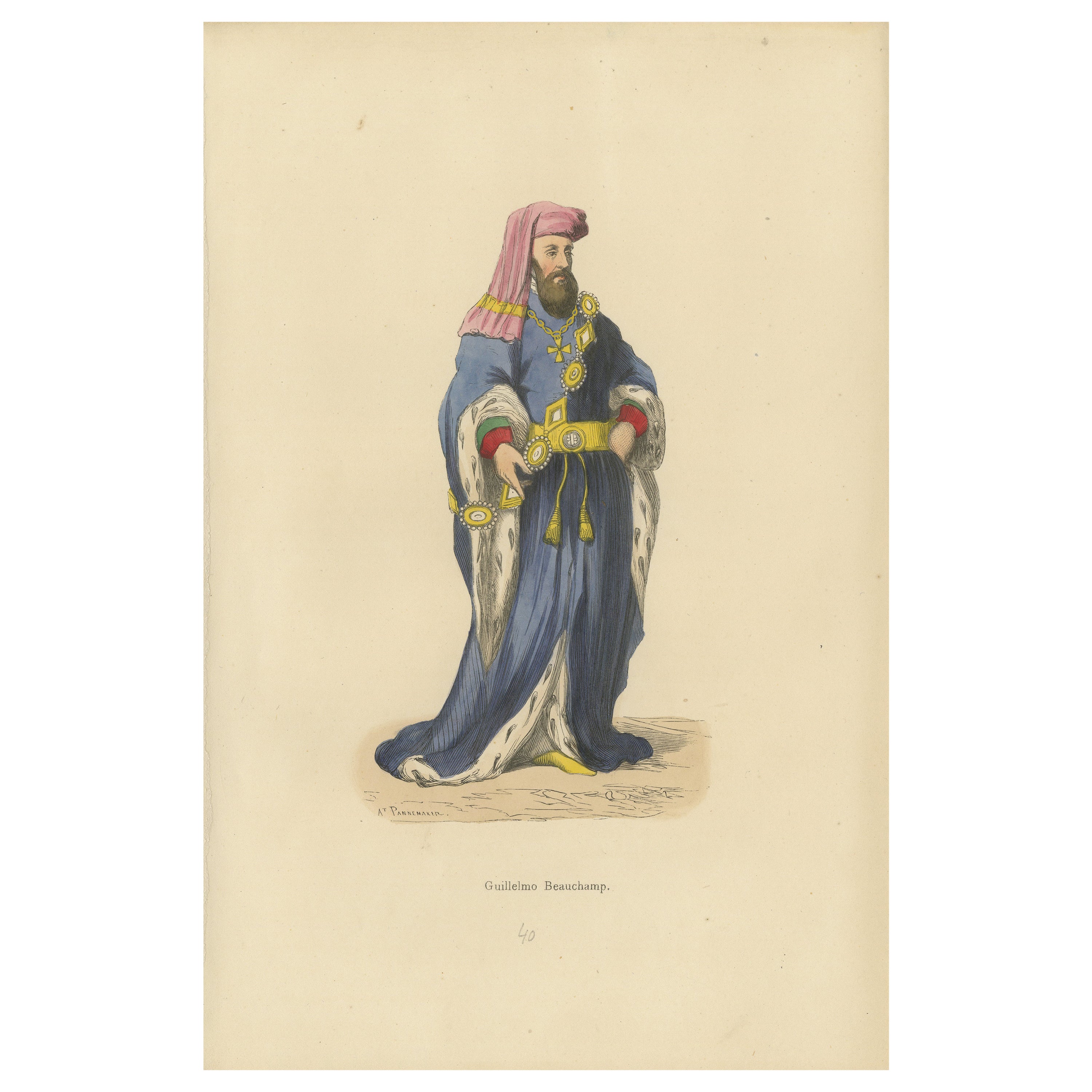Items Similar to The Esteemed Jurist: A Magistrate's Robe in an Original Lithograph, 1847
Want more images or videos?
Request additional images or videos from the seller
1 of 6
The Esteemed Jurist: A Magistrate's Robe in an Original Lithograph, 1847
About the Item
Title: "The Esteemed Jurist: A Magistrate's Robe in 'Costume du Moyen Âge'"
Description: This lithograph, originating from the mid-19th century "Costume du Moyen Âge" series, presents a magistrate clothed in official judicial regalia. The figure is depicted gesturing with an outstretched arm, perhaps in the act of delivering a verdict or addressing a courtroom.
The magistrate's robe is a rich tapestry of color and detail, indicative of his high status in the legal hierarchy. The outer garment is a vibrant crimson, lined with ermine, a symbol of authority and justice. A golden-yellow under-robe, visible beneath the crimson outer layer, adds to the opulence of the ensemble, featuring elaborate designs that likely signify the magistrate's legal jurisdiction or personal coat of arms.
A red cap, trimmed with gold, adorns his head, marking his office and complementing the color scheme of his attire. The cap's shape and style align with the fashion of the day for those in positions of governance and law.
His expression is solemn and thoughtful, befitting the seriousness of his role in administering justice. The meticulous detailing of his robes, from the fur lining to the intricate patterns, reflects the respect and esteem granted to legal officials in the Middle Ages.
This image not only captures the fashion of a magistrate of the period but also serves as a visual testament to the esteemed position such legal figures held in society. It underscores the importance of dress as a reflection of societal roles and the rule of law during the medieval era.
The colors have a nice glow over them. Historically, egg whites, known as glair, and sometimes egg yolk were indeed used in illumination and painting, particularly in manuscripts, to give colors a brighter appearance and to add a sheen or gloss to the work. This technique was quite common during the Middle Ages and into the Renaissance.
Egg whites can be applied as a varnish over pigments to enhance their brightness and to protect the colors. This application could make the colors appear more vivid and also add a slight glossy sheen to the surface of the image.
Egg yolk, on the other hand, was commonly used as a binding agent in paint. It forms the basis of tempera paint, a medium that was widely used before the advent of oil painting. Egg yolk helps to create a durable and long-lasting color that adheres well to various surfaces.
In the context of the print from 1847, it's less likely that egg whites or yolks were used directly on the print, as by that time, commercial printing processes would have been more advanced and less reliant on such manual methods. However, if this print is a representation of an earlier style or is meant to mimic the appearance of hand-painted manuscripts, the original artists might have employed techniques or materials that gave a similar effect to those achieved with egg-based binders and varnishes.
- Dimensions:Height: 10.63 in (27 cm)Width: 7.09 in (18 cm)Depth: 0 in (0.02 mm)
- Materials and Techniques:
- Period:
- Date of Manufacture:1847
- Condition:Good. Overal light toning and light soiling but the image itself clean and hand-colored almost 200 years ago and still in expliciet colors. Aged paper with typically warm, yellowish-brown hue, mostly around the edges. Study the images carefully.
- Seller Location:Langweer, NL
- Reference Number:
About the Seller
5.0
Platinum Seller
These expertly vetted sellers are 1stDibs' most experienced sellers and are rated highest by our customers.
Established in 2009
1stDibs seller since 2017
1,940 sales on 1stDibs
Typical response time: <1 hour
- ShippingRetrieving quote...Ships From: Langweer, Netherlands
- Return PolicyA return for this item may be initiated within 14 days of delivery.
More From This SellerView All
- Scholar of the Codex: A Medieval Jurist in Study, 1847Located in Langweer, NLThe image depicts a person labeled "Docteur des Lois," which translates to "Doctor of Laws." This term historically refers to an individual who has achieved advanced scholarly status in the field of law, equivalent to the modern term "Juris Doctor." The figure is seated at a lectern, deeply engrossed in a large book, which likely represents legal texts or scholarly works. The individual is attired in a robe with a fur-lined cape, suggesting a status of academic or professional distinction. The robe is red, a color often associated with higher education and learning. The headwear appears to be a type of turban, which was a common academic regalia in certain cultures and times. The setting and attire suggest that this person is a scholar or a high-ranking legal professional, possibly a university professor or a magistrate from the medieval or Renaissance period. Egg whites can be applied as a varnish over pigments to enhance their brightness and to protect the colors. This application could make the colors appear more vivid and also add a slight glossy sheen to the surface of the image. Egg yolk, on the other hand, was commonly used as a binding agent in paint. It forms the basis of tempera paint, a medium that was widely used before the advent of oil painting. Egg yolk helps to create a durable and long-lasting color that adheres well to various surfaces. In the context of the print from 1847, it's less likely that egg whites or yolks were used directly on the print, as by that time, commercial printing processes would have been more advanced and less reliant on such manual methods. However, if this print is a representation of an earlier style or is meant to mimic the appearance of hand-painted...Category
Antique 1840s Prints
MaterialsPaper
- The Proclamation: Judges of the Medieval Court in an Original Lithograph, 1847Located in Langweer, NLThe image depicts a group of men labeled "Juges Diseurs," which translates to "Judges Speakers" or "Speaking Judges." This term could refer to officials who were responsible for proc...Category
Antique 1840s Prints
MaterialsPaper
- The Scales of Justice: An English Criminal Judge in Traditional Robes, 1847Located in Langweer, NLThe image is labeled "Juge criminel anglais," which translates to "English Criminal Judge." The figure depicted is wearing a long, flowing robe with a blue undergarment and a red cape, which is indicative of the traditional robes worn by English judges, especially in higher courts. The judge also wears a white coif, which was a typical head covering for English judges and serjeants-at-law. He carries a staff, which may symbolize authority or the office of the judiciary. His belt is richly decorated, suggesting the importance and high status of his position within the legal system. The robes and coif show significant detail, such as the fur lining on the cape and the gold fastening on the belt, which alludes to the formality and solemnity of the judicial office. The judge's expression is stern and somber, reflecting the serious nature of his role in adjudicating criminal matters. Egg whites can be applied as a varnish over pigments to enhance their brightness and to protect the colors. This application could make the colors appear more vivid and also add a slight glossy sheen to the surface of the image. Egg yolk, on the other hand, was commonly used as a binding agent in paint. It forms the basis of tempera paint, a medium that was widely used before the advent of oil painting. Egg yolk helps to create a durable and long-lasting color that adheres well to various surfaces. In the context of the print from 1847, it's less likely that egg whites or yolks were used directly on the print, as by that time, commercial printing processes would have been more advanced and less reliant on such manual methods. However, if this print is a representation of an earlier style or is meant to mimic the appearance of hand-painted manuscripts...Category
Antique 1840s Prints
MaterialsPaper
- John Sitsylt, the Heraldic Knight in an Original Hand-Colored Lithograph of 1847Located in Langweer, NLTitle: "John Sitsylt, the Heraldic Knight: An Illustrated Plate from 'Costume du Moyen Âge'" Description: This 19th-century lithograph, part of the "Costume du Moyen Âge" collection...Category
Antique 1840s Prints
MaterialsPaper
- William de Beauchamp in Noble Attire in An Original Handcolored Lithograph, 1847Located in Langweer, NLThis original antique print portrays a medieval nobleman, identified as "Guillelmo Beauchamp," which may refer to William de Beauchamp, a prominent figure in English history. The nob...Category
Antique 1840s Prints
MaterialsPaper
- Dignified Poise of a Spanish Noblewoman in an Original Lithograph Published 1847Located in Langweer, NLTitle: "Dignified Poise of a Spanish Noblewoman: A Lithographic Study from 'Costume du Moyen Âge'" Description: This striking lithograph from the historic 1847 anthology "Costume du Moyen Âge" portrays a Spanish noblewoman in traditional attire, captured with an essence of nobility and refined grace. The noblewoman is depicted in a three-quarter stance, her gaze gently directed towards the viewer, which creates an intimate connection with the audience. Her dress is a harmony of practicality and elegance, characterized by a full-length, tan cloak that wraps around her figure, edged with a subtle blue stripe that adds a touch of color to the otherwise muted palette. The noblewoman's headdress, a distinctive feature of her ensemble, is a beautifully patterned headscarf, its intricate design suggesting a status of wealth and sophistication. The scarf is secured around her head and beneath her chin, framing her face and highlighting her serene and composed expression. Beneath the cloak, glimpses of a dark undergarment can be seen, suggesting layers that were typical of the era's fashion. Her right hand extends gracefully, perhaps in a gesture of communication or to display her ring, indicative of her marital status and her family's coat of arms. The lithograph demonstrates an exquisite attention to textile and pattern, which not only conveys the fashion of the period but also the cultural identity and social stature of the noblewoman. As with other pieces in the collection, the background is deliberately left blank, focusing all attention on the subject and her costume. This lithographic work serves as both an artistic and historical document, offering insight into the lifestyle and status of noblewomen in medieval...Category
Antique 1840s Prints
MaterialsPaper
You May Also Like
- Original Antique Print of An Ostrich, 1847 'Unframed'Located in St Annes, LancashireGreat image of an ostrich Unframed. It gives you the option of perhaps making a set up using your own choice of frames. Lithograph after Cpt. brown with original hand color. Publi...Category
Antique 1840s English Folk Art Prints
MaterialsPaper
- Original Antique Print of an Eagle, 1847 'Unframed'Located in St Annes, LancashireGreat image of an eagle Unframed. It gives you the option of perhaps making a set up using your own choice of frames. Lithograph after Cpt. brown with original hand color. Publish...Category
Antique 1840s English Folk Art Prints
MaterialsPaper
- Original Antique Print of an Elephant, 1847 'Unframed'Located in St Annes, LancashireGreat image of an elephant. Unframed. It gives you the option of perhaps making a set up using your own choice of frames. Lithograph after Cpt. Brown with original hand color. Pub...Category
Antique 1840s English Folk Art Prints
MaterialsPaper
- Original Antique Print of an Owl, 1847 'Unframed'Located in St Annes, LancashireGreat image of an owl. Unframed. It gives you the option of perhaps making a set up using your own choice of frames. Lithograph after cpt. brown with original hand color. Publishe...Category
Antique 1840s English Folk Art Prints
MaterialsPaper
- Original Antique Print of an English Sporting Dog, 1847Located in St Annes, LancashireGreat image of a bloodhound presented in a distressed antique gilt frame. Lithograph after Cpt. brown with original hand color. Published, 1847.Category
Antique 1840s English Folk Art Prints
MaterialsPaper, Gesso
- Original Antique Print of An English Sporting Dog, 1847 'Unframed'Located in St Annes, LancashireGreat image of a sporting dog, a bloodhound. Unframed. It gives you the option of perhaps making a set up using your own choice of frames. Lithograph after Cpt. Brown with orig...Category
Antique 1840s English Folk Art Prints
MaterialsPaper





